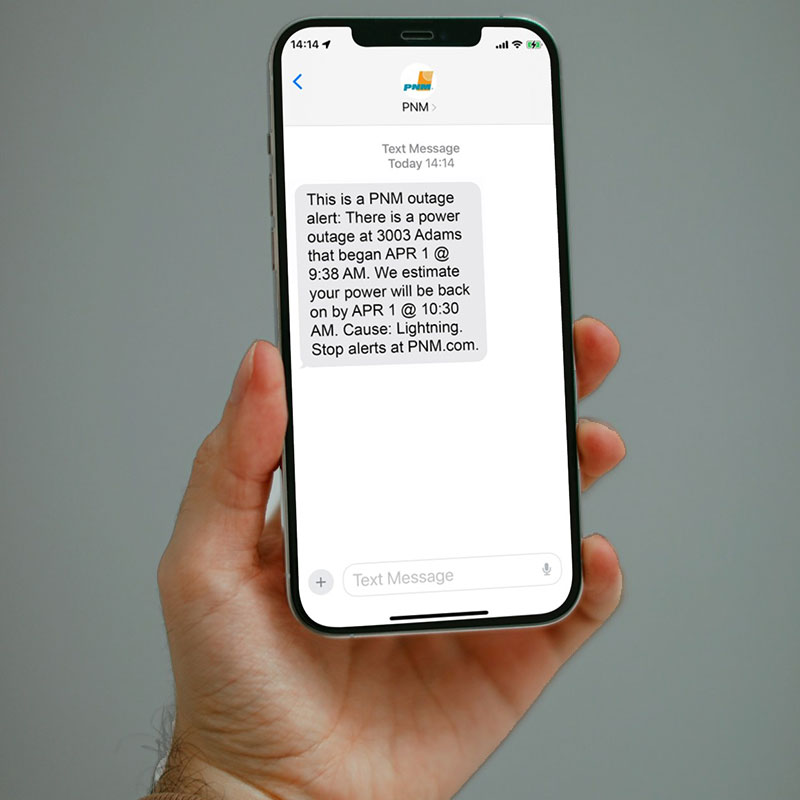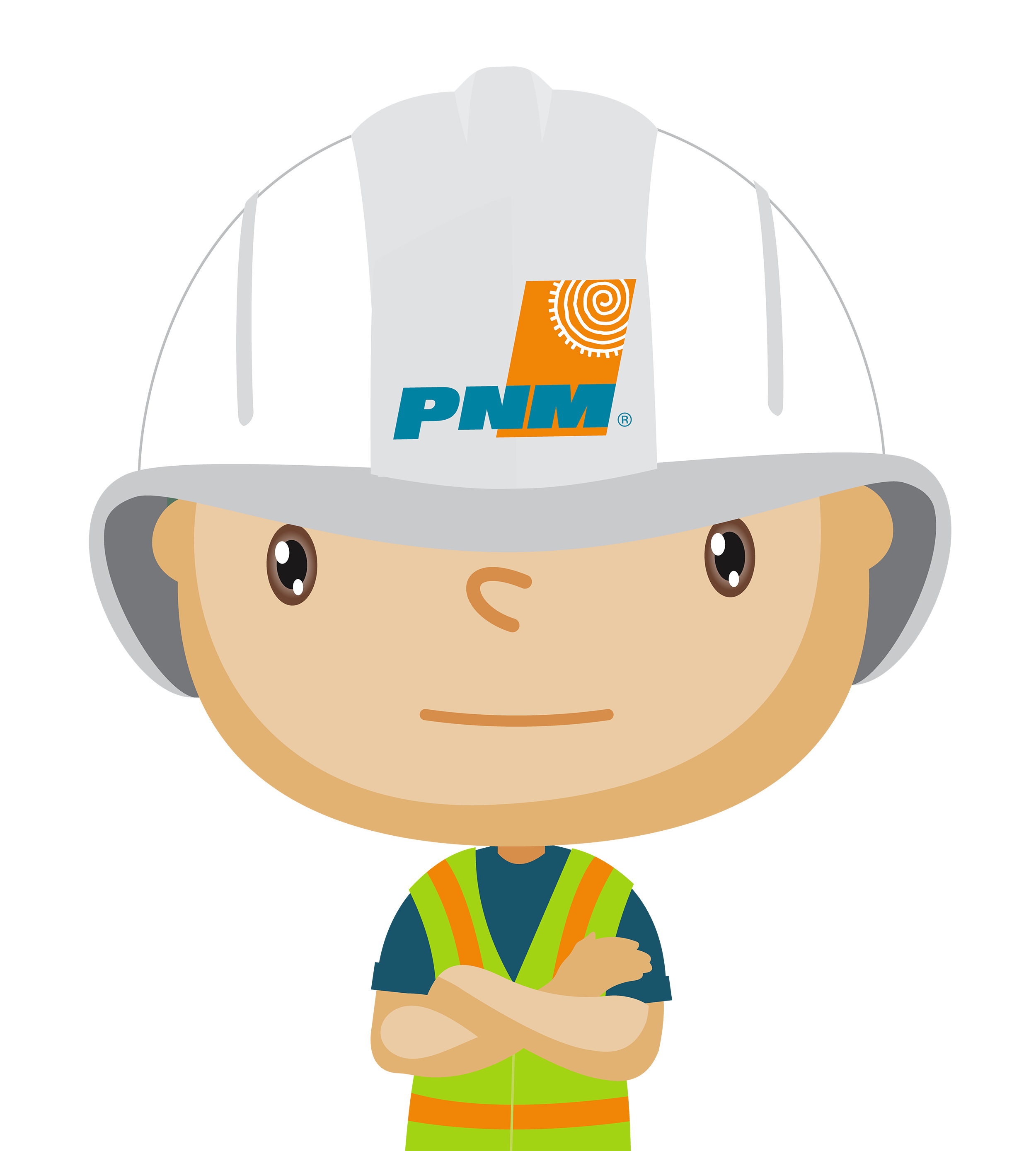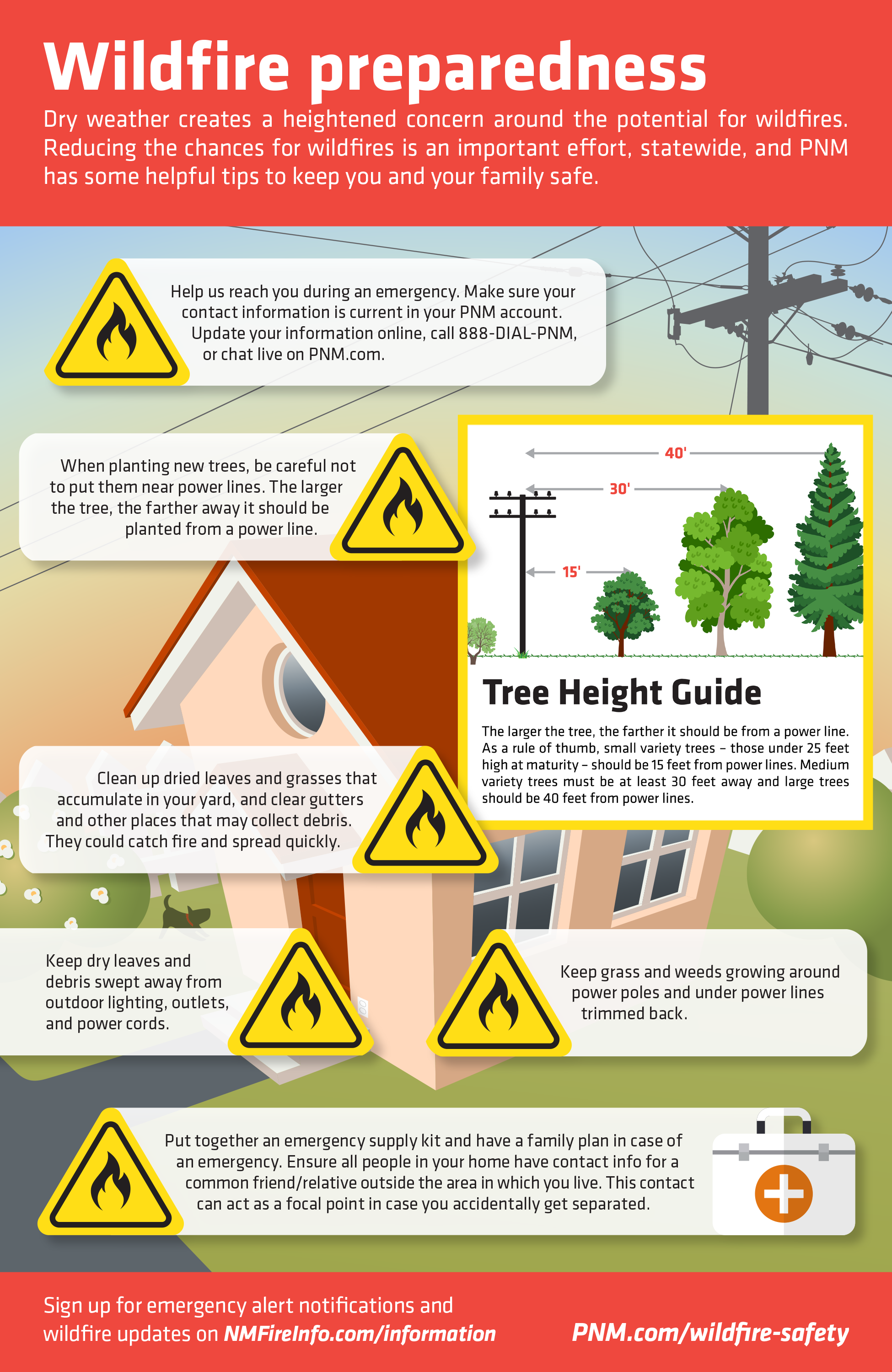Wildfire Safety - pnmprod
Wildfire Safety
Preparing for Wildfire Season
Dry weather is no stranger to New Mexico residents. Dry conditions in our state can mean an increased risk for fires, so it is important for us all to do our part to help prevent wildfires and to prepare for fire season.
PNM Wildfire Mitigation
PNM takes wildfire mitigation very seriously and we work year-round to minimize the risk of wildfires. Safety is the highest priority and we work closely with first responders and forest management agencies to prevent and respond to wildfires.
A comprehensive and detailed Wildfire Mitigation Plan was developed involving Industry Best Practices with strategies addressing Vegetation Management, Inspection & Maintenance, System Protection, Design & Construction, Engineering & Tech Solutions, and Operational Practices.
Below are some things you can do to prepare for wildfire season as well as some things PNM does to prepare.
Questions?
If you have wildfire safety questions that are not addressed on this page, and you'd like to contact us, please click below to submit your questions and/or feedback.
Media inquires should be directed to PNM Media Relations.
Reference Materials
| Title | Download |
|---|---|
| PNM Wildfire Mitigation Plan | Download |
| PNM Public Safety Power Shutoff Plan | Download |
|
Clayton Hazardous Fire Area Map |
Download |
|
Fort Sumner Hazardous Fire Area Map |
Download |
|
Mt. Taylor Hazardous Fire Area Map |
Download |
|
Ruidoso Hazardous Fire Area Map |
Download |
| Sandia Mountains Hazardous Fire Area Map | Download |
|
Santa Fe Hazardous Fire Area Map |
Download |
|
Santa Fe North Hazardous Fire Area Map |
Download |
|
Silver City Hazardous Fire Area Map |
Download |
Sign up for Outage Alerts
We will let you know when a power outage is affecting your home or business, when power is expected to be restored, and when power is restored.
To sign up for alerts login to your PNM account and in the Alerts & Notifications section select Sign Up.


What you can do to prepare
Emergency Kit: Prepare an emergency kit with essential items such as medications, medical supplies, flashlights, batteries, battery or crank radio, non-perishable food, water, and important documents.
Communication Plan: Create a communication plan with at least three contacts who live in different areas and are willing to assist you during a power outage or evacuation. Make sure they are aware of your situation and have a copy of your emergency plan. Do you have phone numbers to authorities beyond 911?
Medical Device Backup: Have backup power sources for medical devices, such as portable generators, extra batteries, or a power bank, to ensure continuous operation during power outages.
Stay Informed: Stay informed about wildfire risks in your area by monitoring local news, weather alerts, and official updates from emergency management authorities.
Evacuation Route: Identify primary and alternate evacuation routes from your home in case of a wildfire evacuation order. Practice the evacuation plan with your contacts.

What PNM does to prepare
Identify and establishes Hazardous Fire Areas (HFAs)
Situational awareness
- Monitor weather daily using meteorological services customized for utilities.
Vegetation Management
- Inspections of rights of ways near our poles and wires.
- Clearing of trees and brush near poles and wires.
- Increased inspections in HFAs
- Use of remote sensing data to identify potential vegetation hazards.
Asset management
- Increased inspection and replacement of equipment in HFAs.
Public Safety Power Shutoff
- Power may temporarily shutoff during dangerous weather conditions to prevent our electric system from becoming a source of ignition.
Sample Wildfire Safety Plan
By having a pre-made plan with multiple contacts in different situations, you increase your chances of receiving timely assistance and support during power outages or evacuations caused by wildfires. Regularly review and update your emergency plan to ensure preparedness and peace of mind.

Neighbor A
Lives nearby and can provide immediate assistance in case of a power outage or evacuation. They have a vehicle and are familiar with your medical (or water) needs.

Friend B
Lives in a different neighborhood but within a reasonable distance. Friend B is aware of your situation and can accommodate you during an evacuation, offering a safe place to stay.

Family Member C
Lives in a different city or town, providing a more distant but reliable option for evacuation if the wildfire threat extends beyond your local area. Family Member C is prepared to travel to assist you in an emergency.
Additional Tips to reduce the risk of wildfires
- Reduce the amount of vegetation around your home. Mow grass and weeds, thin and prune trees and shrubs, and dispose of debris.
- Clean up dried leaves and grasses that accumulate in your yard. They could catch fire and spread quickly.
- Be sure to clear gutters and other places that debris may collect, like under porches and patios.
- Keep dry leaves swept away from outdoor lighting, outlets, and power cords.
- Keep grass and weeds growing around power poles and under power lines trimmed back.
- If you have a pile of firewood, stack it away from your house.
- Put together a family plan in case of an emergency, and prepare for outages ahead of time by preparing an outage kit. Find more information on outage safety and preparedness here. For additional information on disaster supply kits, Ready.gov is a great resource.
- Ensure that all family members in your home have the contact information of a common contact outside the area in which you live. This friend or relative can act as a focal point for your family in case you accidentally get separated.
- Sign up for emergency alert notifications through your county or other local resource. Sign up for wildfire updates on the New Mexico Fire Information website.
- Stay away from downed power lines. Always assume a downed line is energized, even if it's not sparking, arcing, or on fire. Call PNM at 888-DIAL-PNM.
For additional information and tips on preparing your home for wildfire, visit the National Fire Protection Associations website.




